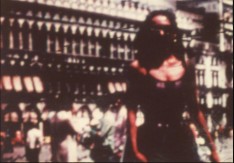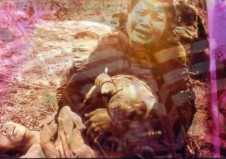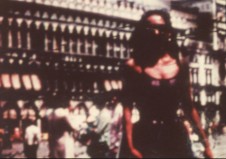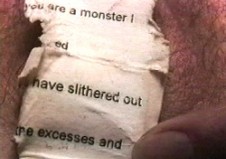Dangerous Erotics: A Tribute to Carolee Schneemann, 8:30 pm

Carolee Schneemann in Plumb Line
FILM AT REDCAT PRESENTS
Dangerous Erotics: A Tribute to Carolee Schneemann
Saturday, February 29, 2020, 4:00 and 8:30 pm
At REDCAT, 631 West 2nd Street, Los Angeles CA 90012
Co-sponsored by the Herb Alpert School of Music at CalArts and Los Angeles Filmforum
In person: Peggy Ahwesh, Maggie Nelson, Lauren Pratt and Kenneth White
https://www.redcat.org/event/her-dangerous-erotics-tribute-carolee-schneemann
REDCAT celebrates the life and work of Carolee Schneemann, one of the great artists of the 20th century, with a panel discussion and selection of her films and videos. Schneemann’s performances, films, paintings and installations were at the center of world art culture from 1960 until her death in 2019. Unrelenting in confronting traditional roles and taboos imposed upon women, Schneemann defiantly embraced female sexuality and physicality with a power and immediacy that remains groundbreaking. Her early investigations into gender and “forbidden aspects of the female experience” (C.S.) laid the groundwork for much feminist art of the 1980s and 90s. The program will feature music by James Tenney, her long-term partner and collaborator.
“In 1963, to use my body as an extension of my painting-constructions,” she later said, “was to challenge and threaten the psychic territorial power lines by which women were admitted to the Art Stud Club.” — Carolee Schneemann
A genius of gesture, word, image, sensuality, and vitality, Carolee Schneemann died at 6 pm on March 6, 2019 in her beloved 18th century Huguenot house in Tillson, New York, surrounded by her cat (and the spirits of so many others) and the comfort of friendships and lovers she had known for decades. Over a lifetime of making art, pleasure, provocations, home, more art and always art—her emotional exactitude and generosity touched the earth, the art world, and the lives of countless human and nonhuman intimates and strangers.— The Brooklyn Rail
“A feminist visionary and one of the most influential artists of the late 20th century.” — The New York Times
“Prior to Schneemann, the female body in art was mute and functioned almost exclusively as a mirror of masculine desire.” — Jan Avgikos, Artforum
“The magnitude of Schneemann's influence is undeniable… When she describes her body as a pleasurable weapon, a missile she sends into our repressive culture to blow it apart, Madonna's in-your-face eroticism immediately comes to mind.” — Jane Harris, Plexus
“Carolee Schneemann was a visionary. She challenged taboos and was undaunted by censorship, including cancelled screenings of her 1967 film Fuses, bans on imagery documenting her 1975 performance Interior Scroll, and attacks on her later political work… Her language is the visceral, yet intensely political, language of the body, of gesture, of sensuality and eroticism. Even today, she remains radical.” — Joy Garnett, National Coalition Against Censorship
“Carolee spent 45 of the 60 active years of her professional career creating work with intensity and integrity, a feminist artist before the art world knew of such a thing…. She shared her ardent attention to the erotics of creative living, her art summing up the intensity of her approach to friends, lovers, cats and her creative practice all meshed into one great life work.” — Amelia Jones, The Guardian
Thanks to Electronic Arts Intermix and the Schneemann Foundation for their support.
Los Angeles Video Premieres!
Tickets: $12 general; $9 for REDCAT and Current Filmforum members
Available for presale at https://web.ovationtix.com/trs/pr/1023333
Only one ticket needed for both shows!
Filmforum members contact us at lafilmforum@yahoo.com for the discount code
7:00pm-8:15pm: Schneemann Videos in REDCAT Lobby
Performance documents:Snows (1967/2009, 20:24 min.) Up To And Including Her Limits (1976, 29 min.), Fresh Blood (1983, 11 min.) and Ask the Goddess (1991, 8:24 min.).
The Artist:
Carolee Schneemann's pioneering work ranges across disciplines, encompassing painting, performance, film and video. Her early and prescient investigations into themes of gender and sexuality, identity and subjectivity, as well as the cultural biases of art history, laid the groundwork for much work of the 1980s and '90s. Her bold challenges to taboo and tradition can be seen as inspiring and influencing artists as varied as Paul McCarthy, Valie Export, the Guerrilla Girls, Tracy Emin and Karen Finley.
While she is often described as a performance artist, Schneemann first studied painting, and that training informed the course of all her subsequent work. It can be seen in her continuing identification as a painter and a formalist, in her attention to art-historical figures such as Cézanne, and in the hand-coloring and mark-making to which she subjected the surface of some of her films. However, the effect of her early experience with painting was also reactive and negative; she recognized, as a woman in the early 1960s working in a male-dominated medium, that "the brush belonged to abstract expressionist male endeavor. The brush was phallic."
This realization coincided with an explosion of new artistic forms, and while Schneemann would never give up painting, she turned her attention to the downtown New York avant-garde's locus of film, dance, theater, and performance. Her involvement with this scene, including work with the Judson Dance Theater and time spent at Warhol's Factory, as well as participation in events such as Robert Morris's Site (1964), in which she appeared onstage as Manet's Olympia, proved crucial to her own concept of what she would call "kinetic theater."
Although she had experimented with performance as early as 1960, her work in this vein went public with the notorious 1964 action and film Meat Joy. This "celebration of flesh as material," replete with naked bodies, raw fish, chickens, and sausages, was contemporaneous with the sensationalist Viennese Aktionist group, and, at least superficially, shared some of the concerns of those artists, who referred to her as their "crazy sister." However, rather than pursuing their interests in the scatological and the morbid, Schneemann presented Meat Joy as an "erotic rite," foregrounding human sexuality and Dionysian ecstasy with a powerful and subversively affirmative spirit.
Schneemann’s undaunted spirit asserted itself even more explicitly a year later in her "anti-porn" collage-film, Fuses, conceived of as a response to work by her friend, the experimental filmmaker Stan Brakhage. The film challenged dominant modes of interpretation, and was also a provocation to both the avant-garde film establishment and the feminist movement.
This go-it-alone criticality is one of the major strands of Schneemann's work. When critiqued for her interest in sexuality and use of her body as medium, she always offered an unapologetic defense, pointing out, for example, "If I am a token, I'll be a token to be reckoned with." Her insistence on integrating the form and content of her art can be seen as quite radical in that it collapses work and life, thought and flesh and nature and. For Schneemann, the focus on the "experiential erotic body" is a method of empowerment, and an antidote to what she sees as a tendency of feminist art historians to discuss female sexuality exclusively as a male construction.
Schneemann's project, then, is in ways concerned with reclaiming those signifiers, actions, and ideas that have historically been denied women, and, to a lesser degree, artists in general. Her work should not solely be viewed as feminist, although she is certainly a pioneer in that area. Rather, her focus has also been on countering traditional art historical accounts, and in mapping what she calls "Istory," in an attempt to see "where the taboos and censorious conventions are embedded aesthetically." This tendency to identify what has been deemed sacred and what has been declared obscene can be seen in works like Art is Reactionary (1987), and in her research into historic artifacts as far-flung as Victorian art-books and Neolithic cave drawings.
Born in 1939 in Fox Chase, Pennsylvania, Schneemann received a B.A. from Bard College and an M.F.A. from the University of Illinois, and holds Honorary Doctor of Fine Arts degrees from the California Institute of the Arts and the Maine College of Art. Her work has been exhibited throughout the world, at institutions including the Museum of Contemporary Art, Los Angeles; the Whitney Museum of American Art, New York; Centre Pompidou, Paris; Centro de Arte Reina Sofía, Madrid; The Museum of Modern Art, New York; National Film Theatre, London; Tate Liverpool, UK, and PPOW Gallery, New York.
In 1997, a pioneering retrospective of Schneemann's work entitled Carolee Schneemann — Up To And Including Her Limits was held at the New Museum of Contemporary Art, New York. A subsequent retrospective of over forty works was exhibited in 2010 at the Samuel Dorsky Museum of Art, State University of New York at New Paltz, and traveled to The Henry Art Gallery, Seattle, and Krannert Art Museum, Champagn, Illinois. Schneemann received a Lifetime Achievement Award from the College Art Association, an Anonymous Was A Woman award, the Ono Lennon Courage Award, and a USA Rockefeller grant, among others. In 2017, she was awarded the Venice Biennale “Golden Lion” for Lifetime Achievement.
Schneemann’s published books include Cezanne, She Was A Great Painter (1976); Early and Recent Work (1983); More Than Meat Joy: Complete Performance Works and Selected Writings (1979), Imaging Her Erotics — Essays, Interviews, Projects (2002). She taught at many institutions, including New York University, California Institute of the Arts, Bard College, and the School of the Art Institute of Chicago.
Carolee Schneemann lived in New Paltz, New York until her death in 2019.
Collage #1: Blue Suede
(1961, 3:24 min., analogue tape/CD) by James Tenney
Jim created the sound collage Blue Suede, a very early example of sampling, while both Carolee and he were MFA students at the University of Illinois and lived in a little farmhouse in Sidney, outside Champaign. Blue Suede, the only one of Jim’s works dedicated “to C.S.” honors both Carolee’s technical influence on Jim’s work—encouraging the transference of her techniques of visual collage into the sonic realm of tape-splicing (hundreds of tiny scraps of tape, cut on a splicing block, and then hours of splicing)—and her emotional, spiritual, and spirited influence. Jim told me that he came up with the idea for the piece after a long session dancing to Elvis, just the two of them, in their tiny Sidney living room, watched by Kitch. Stan Brakhage told me that his favorite part of this work is the part where Elvis says “fuck-fuck”. Jim told me that that part “just happened”. —Lauren Pratt

Viet-Flakes
Viet-Flakes
(1962–67/2015, 8:31 min., 16 mm on HD video, toned b&w, sound collage by James Tenney)
Viet-Flakes was composed from an obsessive collection of Vietnam atrocity images, compiled over five years, from foreign magazines and newspapers. Schneemann uses the 8mm camera to “travel” within the photographs, producing a volatile animation. Broken rhythms and visual fractures are heightened by a sound collage by James Tenney, which features Vietnamese religious chants and secular songs, fragments of Bach, and ’60s pop hits. — Electronic Arts Intermix
”One of the most effective indictments of the Vietnam War ever made.” — Robert Enright, Border Crossings
Carl Ruggles Christmas Breakfast 1963
(1963/2007, 9:02 min, 16 mm on video, color, sound)
“In her earliest film, newly transferred to video, Schneemann presents an abstracted portrait of the American composer Carl Ruggles, known for his irascible personality and finelycrafted atonal music. Ruggles is seen enjoying pie à la mode and ruminating on subjects ranging from Christmas to his incomplete opera The Sunken Bell. The hand-painted film stock heightens the impressionistic vitality of this snapshot of the 84-year-old composer, who is heard paraphrasing Freud: “Everything that you do is a matter of sex. That is the great passion of life.” — Electronic Arts Intermix
Meat Joy
(1964/2010, 10:33 min., color, sound, 16 mm on video)
Writes Schneemann: ”Meat Joy is an erotic rite — excessive, indulgent, a celebration of flesh as material: raw fish, chicken, sausages, wet paint, transparent plastic, ropes, brushes, paper scrap. Its propulsion is towards the ecstatic — shifting and turning among tenderness, wildness, precision, abandon; qualities that could at any moment be sensual, comic, joyous, repellent. Physical equivalences are enacted as a psychic imagistic stream, in which the layered elements mesh and gain intensity by the energy complement of the audience. The original performances became notorious and introduced a vision of the ‘sacred erotic.’ This video was converted from original film footage of three 1964 performances of Meat Joy at its first staged performance at the Festival de la Libre Expression, Paris; Dennison Hall, London; and Judson Church, New York City.”
Body Collage
(1967, 4:12 min., b&w, silent, 16 mm on video)
Body Collage is a visceral “movement-event” from 1967, in which Schneemann paints her body with wallpaper paste and molasses, and then runs, leaps, falls into and rolls through shreds of white printer's paper, creating a physicalized corporal collage. "My intention was not simply to collage my body (as an object), but to enact movement so that the collage image would be active, found, not predetermined or posed," writes Schneemann. This is a newly restored version of this seminal work. — Electronic Arts Intermix

Plumb Line
Plumb Line
(1968–71, 15 min., 16mm, color, sound)
The dissolution of a relationship unravels through visual and aural equivalences. Schneemann splits and recomposes actions of the lovers in a streaming montage of disruptive permutations: 8 mm is printed as 16mm, moving images freeze, frames recur and dissolve until the film bursts into flames, consuming its own substance. The film is a devastating exorcism, as the viewer sees and hears the film approximate the interior memory of the experience. — Electronic Arts Intermix
“Plumb Line was beautiful, laying everything open even more than Fuses — a very public private film — and as clear as crystal.” — David Curtis

Interior Scroll - The Cave
Interior Scroll - The Cave
(1975-1995, 7:31 min., 16mm on HD video, color, sound)
Edited and produced by Maria Beatty.
In a vast underground cave, Schneemann and seven nude women perform the ritualized actions of Interior Scroll — reading the text as each woman slowly extracts a scroll from her vagina. The scroll embodies the primacy of an extended visual line shaped as both concept and action. The extracted text merges critical theory with the body as a source of knowledge. The images move from naked group actions into close-ups of the unraveling text. — Electronic Arts Intermix

Devour
Devour
(2003-04, 8:40 min., HD video, color, sound)
Devour is a single-channel version of the artist’s multi-channel video projection installation of the same name. In this dense montage, the title comes to stand for both the voraciously synthetic head-on rush of contemporary media, and the corresponding near-addictive impulse of its consumers. — Electronic Arts Intermix
“Perceptual tensions drive a range of images edited to contrast evanescent, fragile elements with violent, concussive, speeding fragments. Looped sources of the imagery combine political disasters, domestic intimacy and the ambiguous menace within enlarged details of gestures — both human and mechanical.” — Carolee Schneemann
Pinea Silva
(2012, 9:24 min.)
“Pinea Silva: Lost Meanings of the Christmas Tree, a performance-lecture by Carolee Schneemann, was first presented on December 15, 2011 as part of the 40th Anniversary Benefit at Electronic Arts Intermix (EAI). In Pinea Silva, which takes its name from the Latin for “pine grove” (after a grove on Mount Berecynthus mentioned in Virgil’s Aeneid as sacred to the Roman Mother Goddess Cybele), Schneemann posits a gendered interpretation of the Christmas tree as symbol. Aided by a PowerPoint presentation of images culled from the Internet, the artist analyzes traditional Christmas imagery with an eye toward the psycho-sexual. She interprets how the use of this imagery at Christmastime asserts a hetero-normative culture in which female sexuality is suppressed, and posits the reversal or re-writing of traditional symbols in which the Christmas tree is understood as vulvic.” — Electronic Arts Intermix
